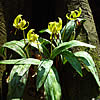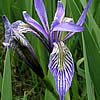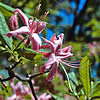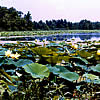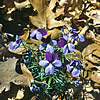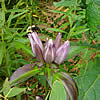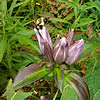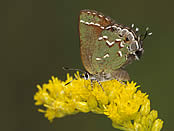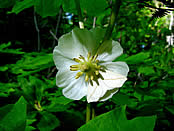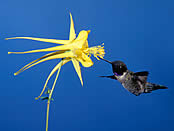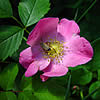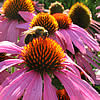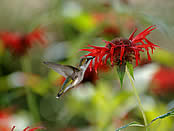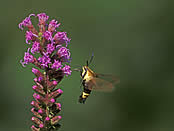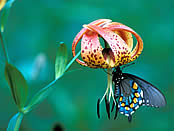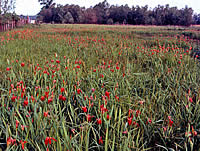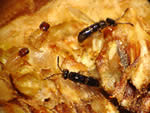USDA Forest Service Celebrating Wildflowers
|
|
|
Plant Pollination StrategiesVisual CuesMany flowers use visual cues to attract pollinators: showy petals and sepals, nectar guides, shape, size, and color. Showy Nectar Guides Shape Fun FactSome flowers have evolved shapes that would seem to defy being pollinated. Such is the case with the bottle gentian (Gentiana andrewsii). In this species of wildflower, a bumblebee comes to the top of the flower and forcibly spreads the corolla open and enters the flower completely. The bumblebee then turns around and exits the flower in the same way. Plants that use visual cues have showy sepals or petals with obvious coloration and color patterns. Plants with red or yellow flowers tend to attract butterflies and hummingbirds. Some flowers feature nectar guides that are specific to particular pollinators. Nectar guides are patterns seen in some flowers that guide pollinators to the nectar and pollen. In many bee-pollinated flowers, there is a region of low ultraviolet reflectance near the center of each petal. The ultraviolet patterns are invisible to humans, as our vision does not detect ultraviolet light, but bees can detect ultraviolet light. This contrasting ultraviolet pattern helps the bee locate the flower's center. Bats and moths that are active at night may locate flowers that are white or a very pale color visually. These nocturnal flowers heavy with fragrance and copious, dilute nectar, attract these pollinators. Flower shape and size provides visual clues and a structure that allows a specific, co-evolved pollinator to contact the flower's anthers and stigmas. Beetle pollinated flowers tend to have larger and more open flowers that provide an easy landing pad since beetles are not as agile in flight as other flying insects. Non-hovering pollinators require landing pads on the flower so they can rest or feed and contact the flower's pollen. The long nectar spurs of plants in the mint family protects the nectar from being stolen by robber insects and allows the nectar to be accessed by the specific pollinators such as hawkmoths, butterflies and hummingbirds that access the nectar with a long proboscis or a long narrow bill.
For a comparison of different flowering types and the pollinators that are attracted to them visit our Pollinator Syndromes web page.
Fun FactIrises produce numerous very large flowers in a spike inflorescence. The flowers are large and numerous to compete with the surrounding flowering plants that are competing for the pollination services of bumblebees. Irises have the energy to invest in these floral displays because of the large rhizomes that can store energy and their leaves can absorb sun light from both surfaces instead of the usual upper surface characteristic of most flowering plants and are aligned in such a manner as to capture direct sunlight throughout the day. |
|
| NOTE: PDF format links require the Adobe Acrobat Reader to view. | |
| top | Disclaimers | FOIA | Privacy Policy | Quality of Information | Photo Credits & Use |
Location: http://www.fs.fed.us/wildflowers/pollinators/plantstrategies/visualcues.shtml
Last modified: Tuesday, 20-May-2008 13:46:23 EDT
